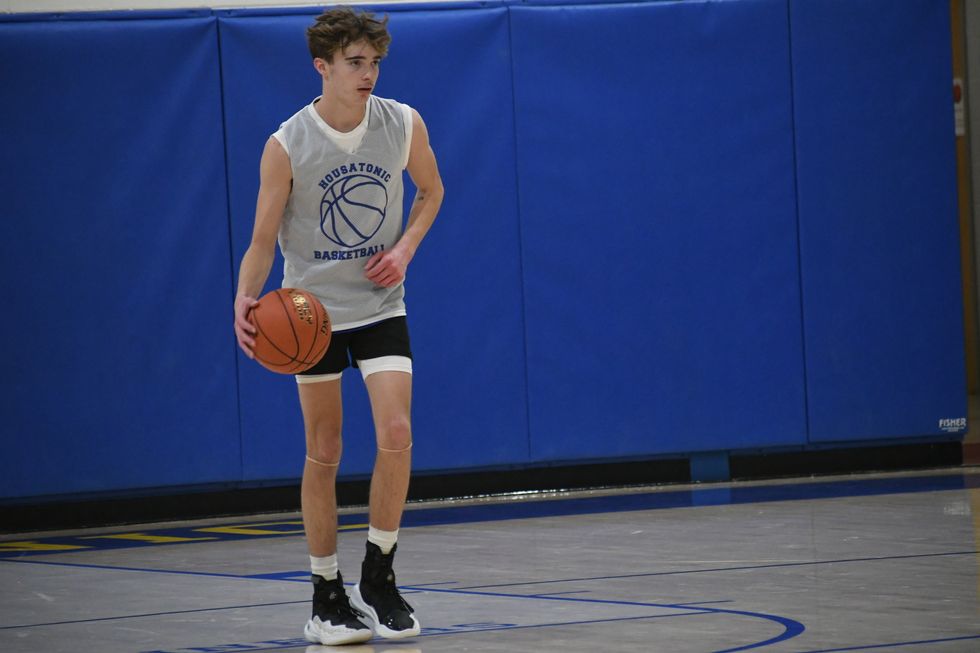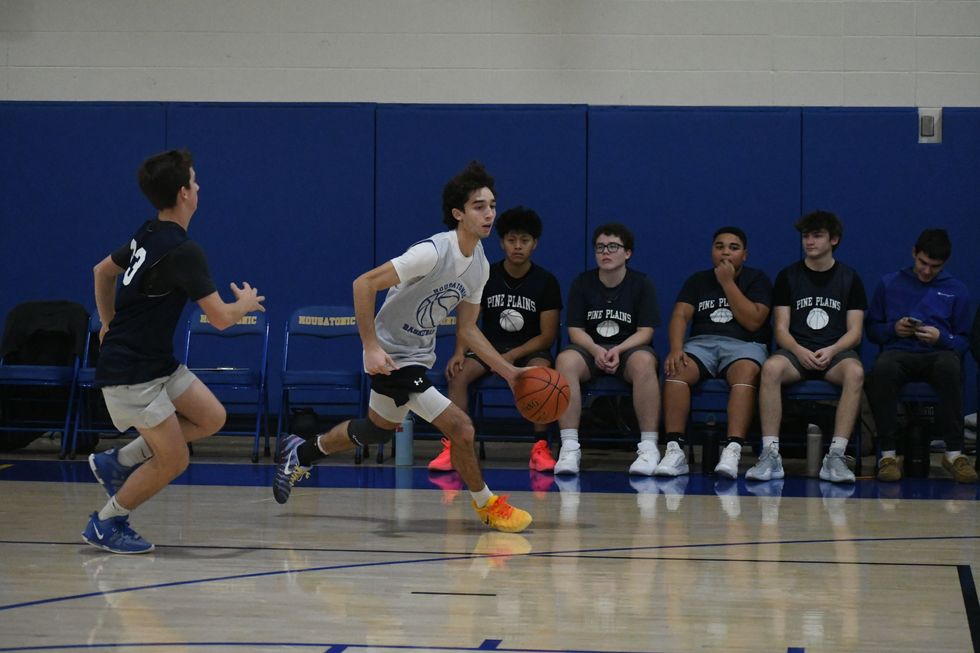Surviving intensifying heat waves

Green frogs hide from the sun under duckweed in a frog pond at the Sharon Audubon Center.
Photo by Alison Robey

When I tell people that I study ecological modeling for a living, the typical response is a wide-eyed stare and some variation of the question, “What on earth is that?”
Assuming most people don’t want to hear about differential equations and population dynamics, I’ve developed an abbreviated response: “Math about plants.”
“Math about plants” is a bit of an oversimplification — I also do math about animals —but it’s an accurate enough description of the research I do as a graduate student in ecology.
My daily work revolves around using equations to understand what is happening in the natural world and why. The questions we ask with those equations are key to the management and use of the environment around us; they range from predicting outbreaks of invasive insects (like the spongy moth) or infectious diseases (like COVID-19), to determining how much carbon is stored in a tree or how many black bears live in Connecticut.
Ecological modeling covers all that and more, but a childhood of canoeing on the Housatonic River and exploring the stonewall-studded forests of Kent has provided my specific equations with a clear central goal: figuring out how to best support these natural places as they face the novel challenges of a changing world.
Right now, we are all recovering from one of those challenges: heat waves.
Long stretches of unusually warm weather can be very disruptive to wildlife. Heat-induced worries for our songbirds and garden toads have real urgency, because while most humans are focused on issues of comfort, like sweaty skin or body odor, these creatures face a real risk of dying.
Most species have spent thousands of years carefully adapting to the very specific temperature ranges in which they usually live. When their internal temperature increases too far above the range they’ve adapted to, their cells become less efficient and more error-prone — problems that are exacerbated by other stressors, like water scarcity, as caused by this summer’s persistent drought.
Luckily, most species have a few tools to deal with uncomfortable heat. Some simply change their behavior, reducing their temperatures by hunting at dusk instead of midday or moving into “temperature refuges” of shady forest canopies and cooling bird baths. Those that cannot capitalize on such refuges rely on much smaller helpers: proteins.
The tiny proteins found in every living organism are both the problem and the solution of overheating. At the microscopic level, our cells build new proteins all the time. However, as cells heat up, they get much worse at making proteins that are the right shape. Misshapen proteins cannot perform their vital functions of building, regulating, and maintaining our anatomy — meaning that, left unchecked, flawed proteins eventually render their cells useless and their overheated organism dead.
Given the prevalence of this problem, cells experiencing heat stress evolved a defense. They produce a new kind of proteins — called “heat shock proteins” — that specialize in fixing or removing the misshapen proteins before they make a mess.
Here’s where the math comes back in. A key goal of climate scientists is predicting how changing conditions on our planet will affect future temperature patterns. For many places around the world, including our corner of Connecticut, those predictions indicate more intense and frequent heat waves in our future.
If we want to know how those predicted heat waves will impact the ecosystems that experience them, then we must know how likely that ecosystem’s organisms are to survive the higher temperatures. To make this prediction, we need to know how high temperatures can get — and how long they can stay there — before heat shock proteins are no longer a match for the heat’s devastating impact on an organism’s cells.
Better foresight about how future temperatures will impact different species helps us make informed decisions about which species to plant while restoring natural areas or as street trees. It also tells us when and where creating and maintaining temperature refuges, like cooling forest canopies or shady ponds, will be most important for protecting plants and animals from the hottest weather.
So as heat waves roll through, provide some shade and water in your greenspaces; your local wildlife appreciates it!
Alison Robey is a volunteer at the Sharon Audubon Center and a second-year PhD student in Ecology and Evolutionary Biology at Yale University.
The Salisbury Winter Sports Association (SWSA) will host its annual Junior Jump Camp, a two-day introduction to ski jumping, on Saturday and Sunday, Dec. 27 and 28, from 9 a.m. to 2 p.m. at Satre Hill in Salisbury.
The camp is open to children ages 7 and up and focuses on teaching the basics of ski jumping, with an emphasis on safety, balance and control, using SWSA’s smallest hill. No prior experience is required.
The cost is $50 per child and includes instruction and lunch on both days. For more information or to register, visit www.skireg.com/swsa-camp or email info@jumpfest.org
Jesse Bunce, first selectman of North Canaan.
LITCHFIELD — The Northwest Hills Council of Governments welcomed six newly elected municipal leaders Thursday, Dec. 11, at its first meeting following the 2025 municipal elections.
The council — a regional planning body representing 21 towns in northwest Connecticut — coordinates transportation, emergency planning, housing, economic development and other shared municipal services.
Barkhamsted First Selectman Meaghan Cook, Goshen First Selectman Seth Breakell, Kent First Selectman Eric Epstein, Norfolk First Selectman Henry Tirrell, North Canaan First Selectman Jesse Bunce and Torrington Mayor Molly Spino were each elected to their post in November.
They filled the seats of their predecessors on the COG, who were each given a toast of appreciation: Nick Lukiwsky (Barkhamsted), Todd Carusillo (Goshen), Marty Lindenmeyer (Kent), Matt Riiska (Norfolk), Brian Ohler (North Canaan) and Elinor Carbone (Torrington).
COG Executive Director Rob Phillips said the outgoing members were given a going away mug that read “You’re living the dream still.” Members voted to appoint Warren First Selectman Greg LaCava to fill a vacancy on the Council’s Executive Committee. COG members voted by paper ballot, and LaCava defeated Burlington First Selectman Doug Thompson for the vacant seat.
Ryan Segalla takes a fadeaway shot over a defender.
FALLS VILLAGE — Housatonic Valley Regional High School’s boys basketball team defeated Pine Plains High School 60-22 in a scrimmage Tuesday, Dec. 9. The non-league preseason game gave both sides an opportunity to run the court ahead of the 2025-26 varsity season.
HVRHS’s senior-heavy roster played with power and poise. The boys pulled ahead early and kept their foot on the gas through to the end.
By halftime the score was 33-8. Junior varsity players subbed in for the second half, but not before the starters got some in-game dunk practice. By the end Housatonic totaled 60 points to Pine Plains’ 22.

Nick Crodelle led the Mountaineers offensively with 13 points. Anthony Labbadia and Wyatt Bayer scored nine points each. Anthony Foley scored eight points. Owen Riemer and Ryan Segalla each scored seven points. Peyton Bushnell hit a three-pointer. Jaxon Visockis and Henry Berry each scored two points.
HVRHS begins Berkshire League competition on the road at Nonnewaug High School Tuesday, Dec. 16, with a 6 p.m. tip off.


Katie Moore delivers toys to the Stuff a Truck campaign held by the Kent Volunteer Fire Department last weekend. Donated toys are collected so that parents, who need some assistance, may provide their children with gifts this Christmas. Accepting the donation are elves Fran Goodsell and Karen Iannucci
KENT — Santa’s elves were toasty warm as they collected toys for the children of Kent.
Keeping with annual tradition, Fran Goodsell and Karen Iannucci manned the Stuff a Truck campaign sponsored by the Kent Volunteer Fire Department on Saturday, Dec. 6, and Sunday, Dec. 7. Sitting in front of a fire pit in the firehouse parking lot between donations from residents, they spoke of the incredible generosity displayed every season. That spirit of giving was clear from the piles of toys heaped on a table.
“This is always so gratifying,” said Goodsell, noting that certain businesses, including High Watch Recovery Center, Wilson’s, and Kent and South Kent schools needed a “shout out” for all they’ve done. She said South Kent School focuses on gifts for older children, which is a group that often is overlooked.
Unwrapped contributions are sought for children 1 to 15 years old who might otherwise find little or nothing from Santa, they said. The bounty will be set up at the Community House on Thursday, allowing parents to come and take what they want. If there are still items left, grandparents are invited to “shop.”
The atmosphere was festive Saturday, as a stuffed dog began barking a Christmas tune whenever someone walked in front of it. A large decked-out bear posted at the parking lot entrance reminded passersby of the event. Visiting children were able to get a close-up look at the fire truck and walk through the firehouse if they wished.
Goodsell and Iannucci were very grateful to those who donated wood for the fire pit. “And so many asked if they could bring us coffee or hot chocolate,” said Iannucci.
Goodsell said many who came talked about having grown children who were recipients of the gifts when their families were struggling. “They are so glad to be able to give back,” she said.